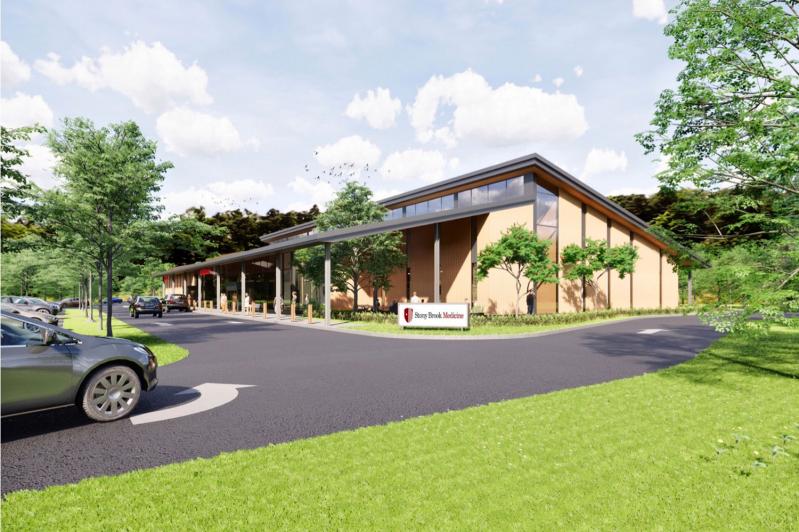A new downsized plan for an emergency room annex Stony Brook Southampton Hospital will build in East Hampton received a mixed reaction from East Hampton Town Planning Board members, who expressed concern about traffic snarls the facility could create.
The annex will be built at 400 Pantigo Place on a 4.5-acre parcel that currently contains two Little League fields. It will be a 911-receiving facility serviced by local emergency medical service teams, and will operate 24 hours a day, seven days a week, as a place to assess, diagnose, and stabilize patients. It will contain a resuscitation and trauma room, two negative pressure rooms used for isolating patients with infectious illnesses, a decontamination room, labs and blood testing areas, an ultrasound, cardiac monitoring services, a CT scanner and X-ray facilities, a designated space for an MRI machine to be purchased at a later date, and pediatric, geriatric, ophthalmology, and obstetrics and gynecology treatment rooms, according to Elizabeth Vail, a lawyer for the hospital.
Pantigo Place is a heavily-trafficked road off of Pantigo Road, part of Route 27, on which the East Hampton Healthcare Foundation medical facility, an office building that houses several municipal departments, and a shopping plaza that includes a branch of Goldberg's Bagels, are located.
In August 2020, the hospital sought site plan approval for a nearly 24,000 square-foot facility, an 810-square-foot garage for an ambulance that would be operated by the hospital, 72 parking spaces (57 for visitors, 15 for employees), a 6,000-gallon diesel generator, and a 400-foot-long lane that would connect to the nearby Town Hall property at 159 Pantigo Road, on which the hospital had sought to build a helipad for emergency transport.
At a July 21 planning board meeting, the hospital presented a revised plan that reduced the size of the main building by nearly 2,000 square feet, eliminated the helipad and access road, reduced the number of parking spaces to 56 (41 for visitors, 15 for employees), and replaced the enclosed garage with a carport.
The helipad was eliminated, Ms. Vail said, because emergency helicopters are allowed to land in any safe, open space. Ian Calder-Piedmonte, a board member, said a helipad could be a life-saving feature, and asked the hospital to explore whether one could be built on the roof of the building.
The diesel generator, which would be used in case of a power outage, also raised concerns among board members, who recommended the use of more environmentally-friendly propane or hooking the generator up to a public gas main. Joanne Violanti, an architect on the project, said that diesel is far more reliable than propane for providing an uninterrupted fuel source, and Robert de Bruin, an engineer, said National Grid's gas line was not large enough to power the generator. National Grid is planning to upgrade its infrastructure in the area, Mr. de Bruin said, and he would check to see if a new main would provide a feasible alternative.
There is a covenant on the parcel that prohibits development within 50 feet of the lot's northern property line, an area in which the hospital is seeking to install a low-nitrogen septic system and drainage control structures. Thomas Crouch, the board's attorney, said the covenant does not restrict such construction because it applies only to residential development.
The parcel is also about 400 feet from the site of a Montaukett burial ground, according to a memo prepared by the Planning Department. During a 1917 excavation, 39 burials and numerous artifacts including jewelry and pottery had been found there. Eric Schantz, a town planner, said the hospital, in collaboration with the New York State Historic Preservation Office, had recently conducted an excavation on the property and found no artifacts.
In 2016, the town board designated the site as a preferred location for an emergency room, and last September it approved changing the parcel's zoning from parks and recreation to commercial-industrial. The zone change would have no significant adverse environmental impact, the board found at the time over the objection of Councilman Jeff Bragman, who said the decision did not factor in the results of a 2020 traffic study, and usurped the authority of the planning board.
Mr. Schantz presented the results of the traffic study to the board on July 21. The study found that the facility would not have a significant impact on traffic on Montauk Highway, but would create long delays for drivers turning onto the highway from Pantigo Place. In existing conditions, a driver seeking to make a left turn from Pantigo Place has to wait an average of 97.6 seconds in the morning, 242.3 seconds in the afternoon, and 520 seconds on Saturdays, according to the study. Once the facility is built, the average wait time would increase to 195.7 seconds, 470.9 seconds, and 861.6 seconds, respectively. For right turns, the wait would increase from 34.3 to 49.3 seconds in the morning, 55.5 to 124.7 seconds in the afternoon, and 144.5 to 260.3 seconds.
The study recommended that a traffic light be installed at the intersection, but because the State Department of Transportation oversees Montauk Highway, there is no guarantee that one would be installed. "We have to assume there will be no traffic light for the purpose of this review," said Mr. Calder-Piedmonte, who said he was particularly concerned about the impacts on left turns from Pantigo Place. He has a "healthy dose of skepticism" about the effects of building the emergency room there, he said, but "the town board is clearly pushing for this project, and we are a lesser board."
Mr. Schantz said the town board had informed the D.O.T. about the potential need for a traffic signal, but had thus far not received a substantive reply.
Kathy Cunningham, the board's vice chairwoman, said she favored having a roundabout installed rather than a traffic light, so that traffic on Montauk Highway would not be brought to a standstill, but Mr. Calder-Piedmonte said he was against both options because of the impact each would have on highway traffic.
Randy Parsons, a board member, recommended the town explore constructing a service road parallel to the highway that would connect to the northern end of the emergency room and other commercial properties in the area.
The board decided to write a letter to the town board to express its concerns about the impact the facility would have on traffic, and to solicit input on the possibility of installing a roundabout, service road, or other traffic mitigation measures. "We know it's bad. What's the solution? Help us figure it out," said Ed Krug, a board member.




